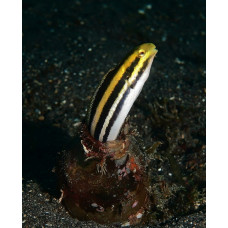Latin name
Petroscirtes breviceps
Other name
Striped fangblenny mimic, short-head sabretooth blenny, short-headed blenny, sabretooth blenny, the black-banded blenny.
Identification
They imitate Meiacanthus grammistes, which, like all species of this genus, has a pair of large fangs with grooves on the lower jaw and associated venom glands. The Papuan species may also be an imitation of Meiacanthus vittatus.
Features of fish fins
Dorsal spines (total): 10-11; Dorsal soft rays (total): 17-21; Anal spines: 2; Anal soft rays: 17-21.
Fish colouring
Have a dark broad band from the snout through the eye to the caudal fin. The band may be segmented. Coloration is very variable and imitates Meiacanthus species.
Distribution
Indo-West Pacific: East Africa to Papua New Guinea, north to southern Japan, south to New Caledonia.
Habitat
A tropical marine species. Usually lives on coral reefs, depth ranges from 1 to 15 meters. Adults inhabit coastal reefs and estuaries. They can be found on coastal reefs and in lagoons, in sandy and weedy areas, among thickets of sargassum or other seaweed. They also find shelter and nests in narrow-necked bottles and abandoned worm tubes or shells.
Size
This species reaches a length of 11 centimeters (4.3 inches).
Behavior
They use their fangs for defense and will not hesitate to bite if touched, so predators avoid members of this genus.
Food and feeding habits
They feed on small crustaceans, diatoms, and possibly other plant material found in such aggregations.
Reproduction
Eggs are bottom dwelling and adhesive, adhering to the substrate with a fibrous adhesive pad. The larvae are planktonic and are often found in shallow coastal waters. They mimic Meiacanthus grammistes, which, like all species of the genus, has a pair of large fangs with grooves on the lower jaw and associated venom glands. These bites are used for defense, and the Papuan species may also be an imitation of Meiacanthus vittatus.
Fishing
Fished for sale to aquariums.
Relationship with a person
Traumatizing to humans.
| Classification | |
| Phylum | Chordata |
| Class | Actinopterygii |
| Squad | Blenniiformes |
| Family | Blenniidae |
| Genus | Petroscirtes |
| Species | P. breviceps |
| Features | |
| Conservation status | Least Concern |
| Habitat | Pelagic |
| Life span, years | No information |
| Maximum body weight, kg | No information |
| Maximum length, cm | 11 |
| Sailing speed, m/s | No information |
| Threat to people | Not edible |
| Way of eating | Predator |

